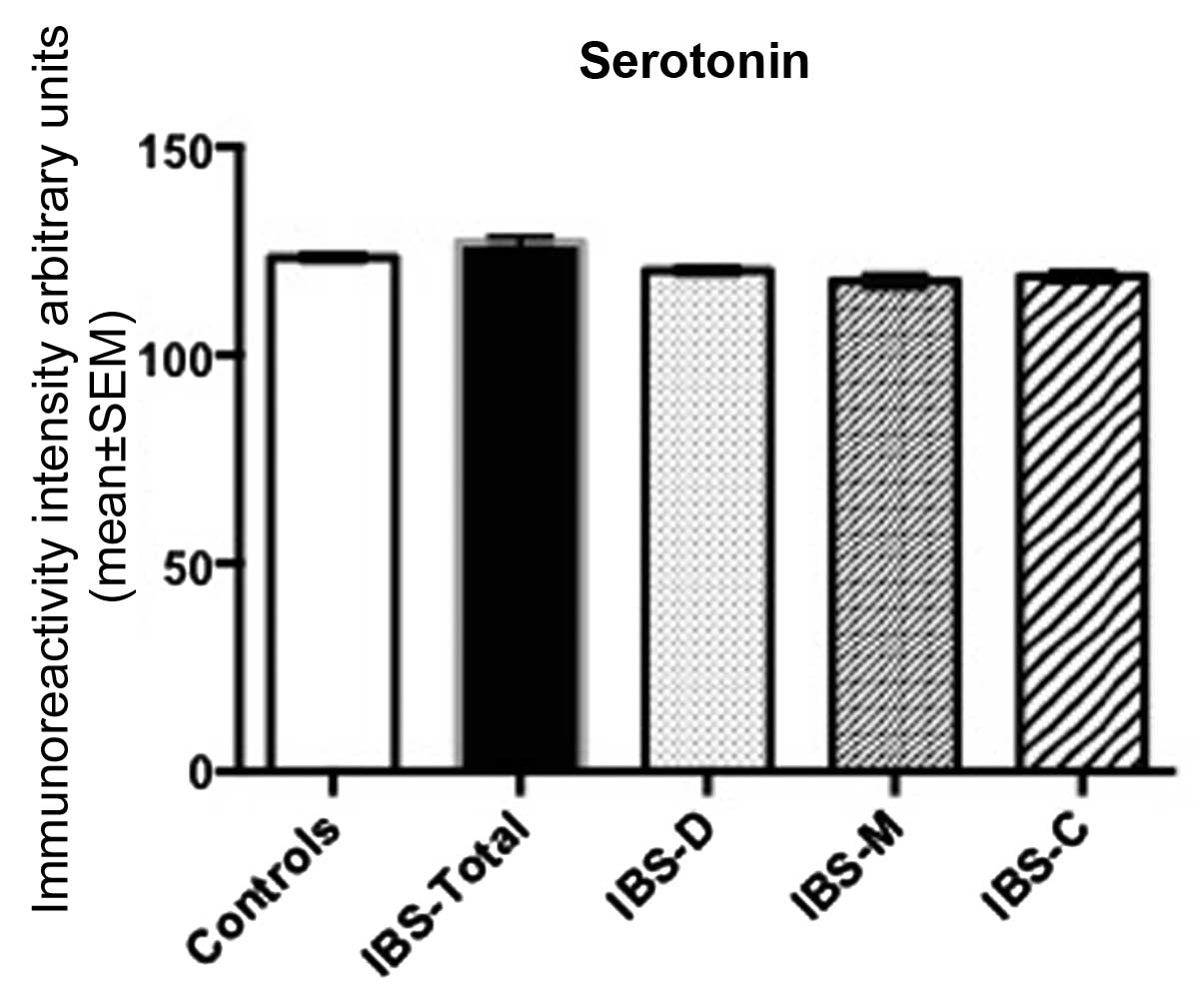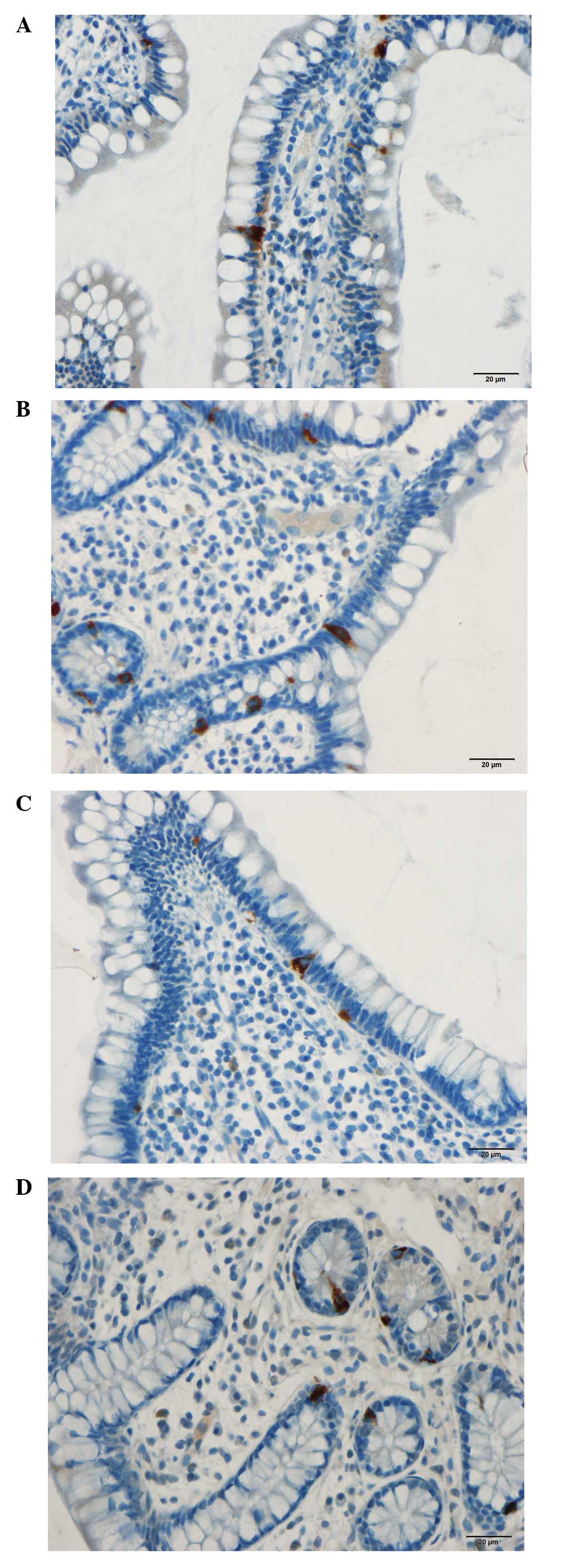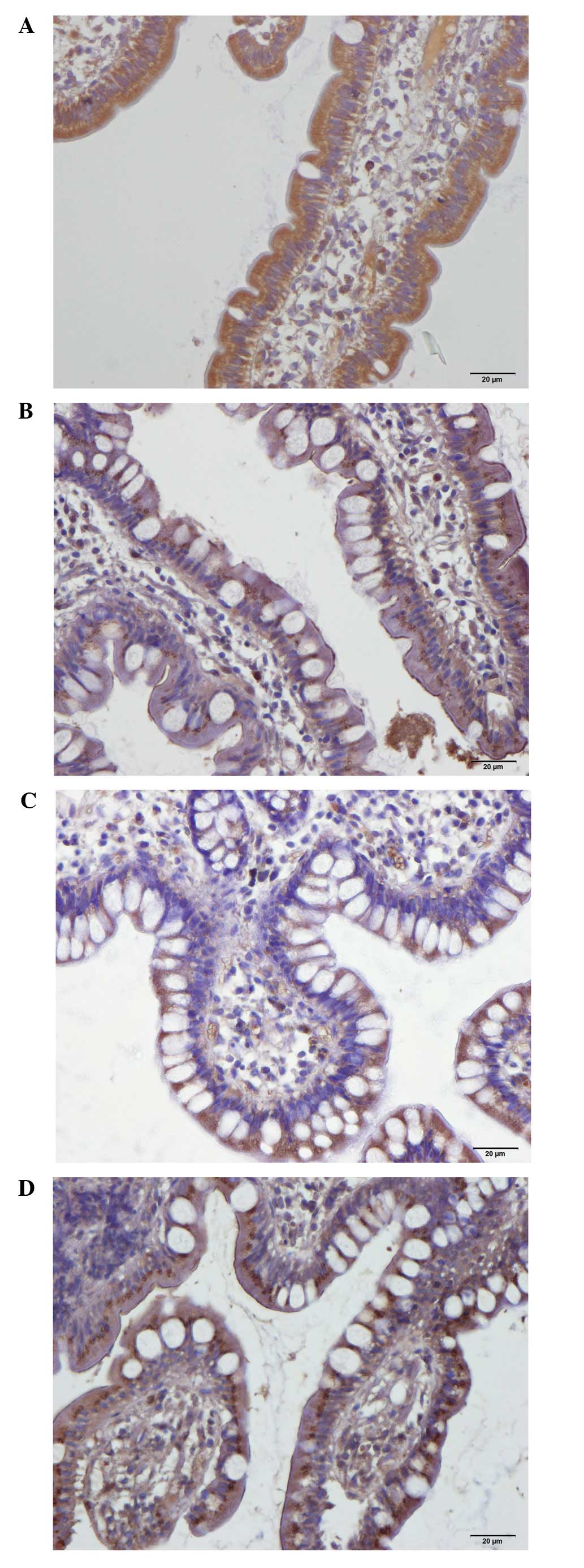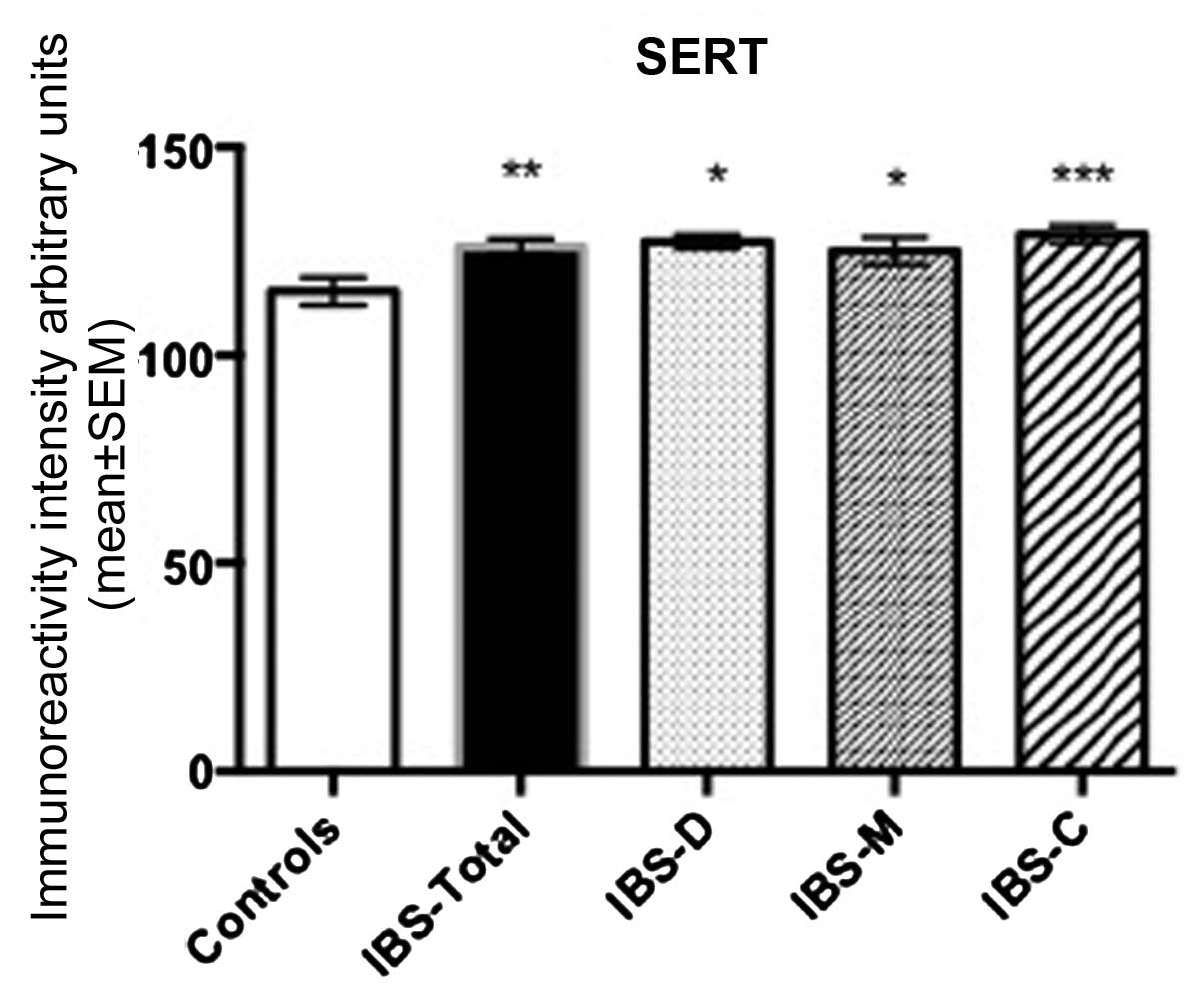Increased serotonin transporter immunoreactivity intensity in the ileum of patients with irritable bowel disease
- Authors:
- Published online on: November 8, 2013 https://doi.org/10.3892/mmr.2013.1784
- Pages: 180-184
Abstract
Introduction
Irritable bowel syndrome (IBS) is a common chronic gastrointestinal disorder (1–9). It occurs primarily at a young age, with a female predominance and causes lifelong illness (2,10–21). IBS considerably reduces the quality of life of the patients due to the uncomfortable symptoms associated with the syndrome, which are often found embarrassing and humiliating and thus interfere with education, working ability and social interactions. Furthermore, IBS represents an economic burden to society caused by overconsumption of healthcare resources and lower work productivity of IBS patients (9,13,20,22–24).
The diagnosis of IBS is based primarily on symptom assessment, including the Rome III criteria (25,26). Patients with IBS suffer from abdominal discomfort or pain, altered bowel habits and bloating/abdominal distension (1,2). Based on the stool pattern, patients with IBS are subdivided, according to Rome III criteria, into four subtypes, namely diarrhoea-predominant (IBS-D), constipation-predominant (IBS-C), mixed diarrhoea and constipation (M-IBS) and unclassified IBS (U-IBS) (25,26).
Serotonin producing cells occur in large numbers in the mucosa of the majority of segments of the gastrointestinal tract and represent the main source of serotonin in the human (27–29). Serotonin acts upon sensory and motor neurons in the submucosal and myenteric ganglia as well as in the spinal cord (27). This, in turn, stimulates motor, secretory and vasodilatory reflexes as well as afferent signals to the central nervous system (27). Serotonin, following acting on its receptors, is transported by serotonin-selective reuptake transporter (SERT) into gut epithelial cells, where it is degraded (27,30). The gut mucosa has a high capacity for the production of SERT as all the epithelial cells lining the luminal surface of the gut express SERT (29,31). Serotonin cell densities in the ileum and colon were reduced in IBS patients compared with those in the duodenum and rectum which were unchanged (32–36). However, SERT immunoreactivity intensity has been observed to be high in the rectum (36,37).
In the present study the immunoreactivity intensity of serotonin and SERT was investigated in the ileum of the same cohort of IBS patients where low density of ileal serotonin cells were found (32).
Materials and methods
Patients and controls
Ninety-eight patients (77 females and 21 males; mean age, 35 years; range, 18–66 years), which fulfilled Rome III Criteria for IBS were included in the study (25,38). The IBS subtypes were distributed as follows: 35 patients with IBS-D, 31 patients with IBS-M and 32 patients with IBS-C. Symptoms had been present in all patients for a number of years and the onset of IBS symptoms were not associated with any events, in particular gastrointestinal infections. All patients underwent a complete physical examination and were investigated using the following blood tests: Full blood count, electrolytes, inflammatory markers, liver tests and thyroid function tests. Patients also underwent further gastroscopy with duodenal biopsies, which were used to exclude celiac disease.
A total of 27 subjects who underwent colonoscopy (16 females and 11 males; mean age, 52 years; range, 20–69 years) were used as controls. These subjects underwent a colonoscopy for the following reasons: Gastrointestinal bleeding, where the source of bleeding was identified as haemorrhoids (n=18) or angiodysplasia (n=2) and health worries resulting from a relative being diagnosed with colon carcinoma (n=7).
The study was performed in accordance with the Declaration of Helsinki and was approved by the Regional Committee for Medical and Health Research Ethics, Health West, University of Bergen (Bergen, Norway). All subjects provided oral and written consent.
Colonoscopy, histopathology and immunohistochemistry
Colonoscopy was performed on the patients and controls, segmental biopsy specimens were taken from the colon and rectum and four biopsy samples were extracted from the ileum of each subject. These biopsy samples were fixed overnight in 4% buffered paraformaldehyde, embedded in paraffin and sliced into 5-μm sections. The sections were stained with hematoxylin and eosin (H&E) and immunostained by the avidin-biotin complex (ABC) method using the Vectastain ABC kit (Vector Laboratories, Burlingame, CA, USA). The sections were hydrated and immersed in phosphate-buffered saline buffer (PBS; pH 7.4) and were incubated with the primary antibodies at room temperature for 2 h. The sections were washed in PBS buffer and incubated with biotinylated swine anti-mouse IgG (Vector Laboratories) diluted 1:100 for 30 min at room temperature. Following washing the slides in PBS buffer, the sections were incubated for 30 min with avidin-biotin-peroxidase complex diluted 1:100 and immersed in 3,3′-diaminobenzidine (DAB) peroxidase substrate (Vector Laboratories), followed by counterstaining in hematoxylin. The primary antibodies used were monoclonal mouse anti-serotonin (code no. 5HT-209; Dako, Carpinteria, CA, USA) and mouse anti-human serotonin transporter (code no. GR120164-1; Abcam, Cambridge, MA, USA). The antibodies were used at dilutions of 1:1,500 and 1:500, respectively.
Computerised image analysis
The immunoreactivity intensities of serotonin and SERT were measured using Olympus cellSens imaging software (version 1.7). A ×20 magnification was used, for which each frame (field) displayed on the monitor represented an area of 0.14 mm2 of the tissue. In each individual, serotonin and SERT were measured in five randomly selected fields. Immunostained sections from IBS patients and controls were coded and mixed and all measurements were assessed by the same person without knowledge of the identity of the sections.
Statistical analysis
Differences between controls, all IBS patients (IBS-total) and IBS-D, IBS-M and IBS-C patients were analysed by the Kruskal-Wallis nonparametric test with Dunn’s test as a post-test. The data are presented as the mean ± standard error of the mean values and P<0.05 was considered to indicate a statistically significant difference.
Results
Endoscopy and histopathology
The ileum, colon and rectum of the patients and the control subjects were macroscopically normal. The results of histopathological examinations of the ileum, colon and rectum were normal in the patients and controls.
Immunohistochemistry and computerised image analysis
In the patients and control subjects, serotonin-immunoreactive cells were found primarily in the intestinal crypts. These cells were basket- or flask-shaped. SERT immunoreactivity was observed in the lining epithelium of the ileum in the patients and controls.
Serotonin immunoreactivity intensity
The immunoreactivity intensity of serotonin in the controls was 121.7±0.8. The corresponding figures for IBS-total, IBS-D, IBS-M and IBS-C were 122.9±2.0, 120.3±1.1, 117.8±1.7 and 118.9±1.3, respectively. There was no statistical difference in multiple comparisons between controls, IBS-total, IBS-D and IBS-C (P=0.3). The post-test did not reveal any statistical differences between the four groups (P<0.05 in all; Figs. 1 and 2).
SERT immunoreactivity intensity
The immunoreactivity intensity of SERT in controls, IBS-total, IBS-D, IBS-M and IBS-C were 115.4±3.3, 126.1±1.9, 127.3±1.6, 125.1±3.2 and 129.1±2.1, respectively (Figs. 3 and 4). There was a significant statistical difference in multiple comparisons between controls, IBS-total, IBS-D, IBS-M and IBS-C (P=0.0005). SERT immunoreactivity intensity of IBS-total, IBS-D, IBS-M and IBS-C differed significantly from that of controls (P<0.01, P<0.05, P <0.05 and P <0.001, respectively).
Discussion
The rapid advances in the software for computer image analysis has rendered it possible to measure the intensity of the colour product of immunohistochemical staining for a specific intracellular substance. This intensity reflects the cellular contents of this particular substance. These measurements are useful in comparing similar tissue from different groups treated in the same conditions during immunostaining.
The present study showed that whereas the immunoreactivity intensity of serotonin in the ileum of IBS patients did not differ from that in control subjects, the immunoreactivity intensity of SERT increased regardless of the IBS subtypes. These observations were noted in the same cohort of IBS patients, where the ileal serotonin cells were lower compared with the control subjects, regardless of the IBS subtype (32). The normal cellular content of serotonin, as reflected by the immunoreactivity intensity and the reduction in the number of cells in the ileum of IBS patients implicates a decrease in the mucosal serotonin. The increase in ileal epithelial content of SERT, as indicated by increased immunoreactivity intensity, may increase the intracellular uptake of serotonin and its degradation in the gut epithelial cells and consequently decrease the availability of serotonin within the gut mucosa (39,40). The present findings and the earlier observations (32) indicate that there is a decrease in the production of serotonin and a rapid degradation resulting in the low availability of serotonin at its receptors in the ileum of IBS patients.
The low availability of serotonin at it receptors in the ileum of IBS patients appear to occur in all IBS subtypes. This may indicate that this abnormality is associated with a common symptom in all IBS subtypes, which is abdominal pain/discomfort. It is possible that the abnormality in the ileum serotonin signalling system observed in the present study is responsible for the development of this common symptom in IBS patients. In agreement with this hypothesis, serotonin acts upon sensory neurons in the submucosal and myenteric ganglia as well as in spinal cord (27). The abnormality observed in this study in SERT may be genetic, as genetic abnormalities concerning SERT have been observed in IBS patients (41–50). The present observations may have an impact in the use of serotonin agonists and antagonists in the treatment of IBS patients.
Acknowledgements
The authors would like to thank Hans-Olav Fadnes for his support during the course of the study and for reading and commenting on the manuscript. This study was supported by a grant from Helse-Fonna.
References
|
Thompson WG: A world view of IBS. Irritable Bowel Syndrome. Camilleri M and Spiller RC: Saunders; Philadelphia and London: pp. 17–26. 2002 | |
|
Drossman DA, Li Z, Andruzzi E, et al: U.S. householder survey of functional gastrointestinal disorders. Prevalence, sociodemography, and health impact. Dig Dis Sci. 38:1569–1580. 1993. View Article : Google Scholar : PubMed/NCBI | |
|
El-Salhy M, Gundersen D, Hatlebakk JG and Hausken T: Irritable Bowel Syndrome: Diagnosis, Pathogenesis and Treatment Options. Nova Science Publishers; New York: 2012 | |
|
Ford AC and Vandvik PO: Irritable bowel syndrome. Clin Evid (Online). 2012:04102012. | |
|
Lovell RM and Ford AC: Global prevalence of and risk factors for irritable bowel syndrome: a meta-analysis. Clin Gastroenterol Hepatol. 10:712–721. 2012. View Article : Google Scholar : PubMed/NCBI | |
|
Quigley EM, Locke GR, Mueller-Lissner S, et al: Prevalence and management of abdominal cramping and pain: a multinational survey. Aliment Pharmacol Ther. 24:411–419. 2006. View Article : Google Scholar : PubMed/NCBI | |
|
Vandvik PO, Lydersen S and Farup PG: Prevalence, comorbidity and impact of irritable bowel syndrome in Norway. Scand J Gastroenterol. 41:650–656. 2006. View Article : Google Scholar : PubMed/NCBI | |
|
Saito YA, Schoenfeld P and Locke GR III: The epidemiology of irritable bowel syndrome in North America: a systematic review. Am J Gastroenterol. 97:1910–1915. 2002.PubMed/NCBI | |
|
Whitehead WE, Burnett CK, Cook EW III and Taub E: Impact of irritable bowel syndrome on quality of life. Dig Dis Sci. 41:2248–2253. 1996. View Article : Google Scholar : PubMed/NCBI | |
|
Agréus L, Svärdsudd K, Nyrén O and Tibblin G: Irritable bowel syndrome and dyspepsia in the general population: overlap and lack of stability over time. Gastroenterology. 109:671–680. 1995.PubMed/NCBI | |
|
Thompson WG and Heaton KW: Functional bowel disorders in apparently healthy people. Gastroenterology. 79:283–288. 1980.PubMed/NCBI | |
|
Kennedy TM, Jones RH, Hungin AP, O’flanagan H and Kelly P: Irritable bowel syndrome, gastro-oesophageal reflux, and bronchial hyper-responsiveness in the general population. Gut. 43:770–774. 1998. View Article : Google Scholar : PubMed/NCBI | |
|
Talley NJ, Gabriel SE, Harmsen WS, Zinsmeister AR and Evans RW: Medical costs in community subjects with irritable bowel syndrome. Gastroenterology. 109:1736–1741. 1995. View Article : Google Scholar : PubMed/NCBI | |
|
Hungin AP, Whorwell PJ, Tack J and Mearin F: The prevalence, patterns and impact of irritable bowel syndrome: an international survey of 40,000 subjects. Aliment Pharmacol Ther. 17:643–650. 2003. View Article : Google Scholar : PubMed/NCBI | |
|
Jones R and Lydeard S: Irritable bowel syndrome in the general population. BMJ. 304:87–90. 1992. View Article : Google Scholar : PubMed/NCBI | |
|
Bordie AK: Functional disorders of the colon. J Indian Med Assoc. 58:451–456. 1972.PubMed/NCBI | |
|
O’Keefe EA, Talley NJ, Zinsmeister AR and Jacobsen SJ: Bowel disorders impair functional status and quality of life in the elderly: a population-based study. J Gerontol A Biol Sci Med Sci. 50:M184–M189. 1995.PubMed/NCBI | |
|
Everhart JE and Renault PF: Irritable bowel syndrome in office-based practice in the United States. Gastroenterology. 100:998–1005. 1991.PubMed/NCBI | |
|
Wilson S, Roberts L, Roalfe A, Bridge P and Singh S: Prevalence of irritable bowel syndrome: a community survey. Br J Gen Pract. 54:495–502. 2004.PubMed/NCBI | |
|
Harvey RF, Salih SY and Read AE: Organic and functional disorders in 2000 gastroenterology outpatients. Lancet. 1:632–634. 1983. View Article : Google Scholar : PubMed/NCBI | |
|
Spiegel BM: The burden of IBS: looking at metrics. Curr Gastroenterol Rep. 11:265–269. 2009. View Article : Google Scholar : PubMed/NCBI | |
|
Gralnek IM, Hays RD, Kilbourne A, Naliboff B and Mayer EA: The impact of irritable bowel syndrome on health-related quality of life. Gastroenterology. 119:654–660. 2000. View Article : Google Scholar : PubMed/NCBI | |
|
Drossman DA, Morris CB, Schneck S, et al: International survey of patients with IBS: symptom features and their severity, health status, treatments, and risk taking to achieve clinical benefit. J Clin Gastroenterol. 43:541–550. 2009. View Article : Google Scholar | |
|
Sandler RS, Everhart JE, Donowitz M, et al: The burden of selected digestive diseases in the United States. Gastroenterology. 122:1500–1511. 2002. View Article : Google Scholar : PubMed/NCBI | |
|
Longstreth GF, Thompson WG, Chey WD, Houghton LA, Mearin F and Spiller RC: Functional bowel disorders. Gastroenterology. 130:1480–1491. 2006. View Article : Google Scholar : PubMed/NCBI | |
|
Drossman DA: Rome III: the new criteria. Chin J Dig Dis. 7:181–185. 2006. View Article : Google Scholar : PubMed/NCBI | |
|
Mawe GM, Coates MD and Moses PL: Review article: intestinal serotonin signalling in irritable bowel syndrome. Aliment Pharmacol Ther. 23:1067–1076. 2006. View Article : Google Scholar : PubMed/NCBI | |
|
Erspamer V: Occurrence and distribution of 5-hydroxytryptamine (enteramine) in the living organism. Z Vitam Horm Fermentforsch. 9:74–96. 1957.PubMed/NCBI | |
|
Chen JX, Pan H, Rothman TP, Wade PR and Gershon MD: Guinea pig 5-HT transporter: cloning, expression, distribution, and function in intestinal sensory reception. Am J Physiol. 275:G433–G448. 1998.PubMed/NCBI | |
|
Spiller R and Lam C: An update on post-infectious irritable bowel syndrome: role of genetics, immune activation, serotonin and altered microbiome. J Neurogastroenterol Motil. 18:258–268. 2012. View Article : Google Scholar : PubMed/NCBI | |
|
Coates MD, Mahoney CR, Linden DR, et al: Molecular defects in mucosal serotonin content and decreased serotonin reuptake transporter in ulcerative colitis and irritable bowel syndrome. Gastroenterology. 126:1657–1664. 2004. View Article : Google Scholar : PubMed/NCBI | |
|
El-Salhy M, Gundersen D, Hatlebakk JG and Hausken T: Abnormal endocrine cells in the ileum of patients with irritable bowel syndrome. World J Gastroenterol. 2013.(In press). | |
|
El-Salhy M, Gundersen D, Ostgaard H, Lomholt-Beck B, Hatlebakk JG and Hausken T: Low densities of serotonin and peptide YY cells in the colon of patients with irritable bowel syndrome. Dig Dis Sci. 57:873–878. 2012. View Article : Google Scholar : PubMed/NCBI | |
|
El-Salhy M, Vaali K, Dizdar V and Hausken T: Abnormal small-intestinal endocrine cells in patients with irritable bowel syndrome. Dig Dis Sci. 55:3508–3513. 2010. View Article : Google Scholar : PubMed/NCBI | |
|
El-Salhy M, Gundersen D, Hatlebakk JG and Hausken T: Abnormal rectal endocrine cells in patients with irritable bowel syndrome. Regul Pept. 2013.(In press). | |
|
Coates MD, Johnson AC, Greenwood-Van Meerveld B and Mawe GM: Effects of serotonin transporter inhibition on gastrointestinal motility and colonic sensitivity in the mouse. Neurogastroenterol Motil. 18:464–471. 2006. View Article : Google Scholar : PubMed/NCBI | |
|
El-Salhy M, Wendelbo I and Gundersen D: Serotonin and serotonin transporter in the rectum of patients with irritable bowel disease. Mol Med Rep. 8:451–455. 2013.PubMed/NCBI | |
|
Spiller R, Aziz Q, Creed F, et al: Guidelines on the irritable bowel syndrome: mechanisms and practical management. Gut. 56:1770–1798. 2007. View Article : Google Scholar : PubMed/NCBI | |
|
Keating C, Beyak M, Foley S, et al: Afferent hypersensitivity in a mouse model of post-inflammatory gut dysfunction: role of altered serotonin metabolism. J Physiol. 586:4517–4530. 2008. View Article : Google Scholar : PubMed/NCBI | |
|
Coleman NS, Foley S, Dunlop SP, et al: Abnormalities of serotonin metabolism and their relation to symptoms in untreated celiac disease. Clin Gastroenterol Hepatol. 4:874–881. 2006. View Article : Google Scholar : PubMed/NCBI | |
|
Camilleri M, Andrews CN, Bharucha AE, et al: Alterations in expression of p11 and SERT in mucosal biopsy specimens of patients with irritable bowel syndrome. Gastroenterology. 132:17–25. 2007. View Article : Google Scholar : PubMed/NCBI | |
|
Camilleri M, Busciglio I, Carlson P, et al: Candidate genes and sensory functions in health and irritable bowel syndrome. Am J Physiol Gastrointest Liver Physiol. 295:G219–G225. 2008. View Article : Google Scholar : PubMed/NCBI | |
|
Kumar S, Ranjan P, Mittal B and Ghoshal UC: Serotonin transporter gene (SLC6A4) polymorphism in patients with irritable bowel syndrome and healthy controls. J Gastrointestin Liver Dis. 21:31–38. 2012.PubMed/NCBI | |
|
Park JM, Choi MG, Park JA, et al: Serotonin transporter gene polymorphism and irritable bowel syndrome. Neurogastroenterol Motil. 18:995–1000. 2006. View Article : Google Scholar : PubMed/NCBI | |
|
Saito YA, Larson JJ, Atkinson EJ, et al: The role of 5-HTT LPR and GNβ3 825C>T polymorphisms and gene-environment interactions in irritable bowel syndrome (IBS). Dig Dis Sci. 57:2650–2657. 2012. | |
|
Colucci R, Blandizzi C, Bellini M, Ghisu N, Tonini M and Del Tacca M: The genetics of the serotonin transporter and irritable bowel syndrome. Trends Mol Med. 14:295–304. 2008. View Article : Google Scholar : PubMed/NCBI | |
|
Colucci R, Gambaccini D, Ghisu N, et al: Influence of the serotonin transporter 5HTTLPR polymorphism on symptom severity in irritable bowel syndrome. PloS One. 8:e548312013. View Article : Google Scholar : PubMed/NCBI | |
|
Faure C, Patey N, Gauthier C, Brooks EM and Mawe GM: Serotonin signaling is altered in irritable bowel syndrome with diarrhea but not in functional dyspepsia in pediatric age patients. Gastroenterology. 139:249–258. 2010. View Article : Google Scholar : PubMed/NCBI | |
|
Kim HJ, Camilleri M, Carlson PJ, et al: Association of distinct alpha(2) adrenoceptor and serotonin transporter polymorphisms with constipation and somatic symptoms in functional gastrointestinal disorders. Gut. 53:829–837. 2004. View Article : Google Scholar | |
|
Park CS and Uhm JH: Polymorphisms of the serotonin transporter gene and G-protein β3 subunit gene in Korean children with irritable bowel syndrome and functional dyspepsia. Gut Liver. 6:223–228. 2012. |













